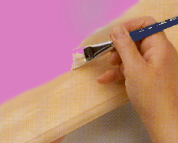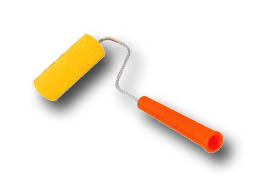Decorative Painting Tips: Basecoating
Read the full Basecoating Guide
-
If mixing your own colour for basecoating,
make sure you mix a good amount so as not to run out before
you complete your basecoating. You might not get the same colour
when you mix it again. More is better.
-
Use a good quality brush with soft bristles
for basecoating - one that you use specifically for painting.
Use a separate brush for varnishing if you can afford it.
- Use the largest brush that will fit on
the area, or in the space. Fewer strokes make for a smoother
finish.


-
When basecoating with a brush, load the
brush with paint as you would normally load it to paint your
design i.e. don't just dip the tip of the brush in the paint
but press the brush down in the puddle of paint so that the
brush hairs open and suck the paint up. Blend a few times on
the palette to make sure the brush is fully loaded with paint.
Never overload the brush with paint for basecoating.
-
Use the brush at a low angle, taking
advantage of the broad side of the brush instead of just the
bristle tips.
- If the paint doesn't seem to flow smoothly,
add a little Flow Medium to the paint instead of water and
mix well. Flow medium does not lighten the colour of your paint,
water does.

-
Several medium or thin coats of basecoat
paint are better than one or two thick coats.
-
For a very smooth finish - dry between
coats using a hairdryer, then lightly sand with 600 grit sandpaper,
wipe down lightly with a cotton rag to remove any dust, and
then apply another coat, sand again and wipe. Repeat up to
three coats. If the last layer feels smooth, you need not sand
anymore. If you are unsatisfied with the texture, sand it lightly
using even higher grit sandpaper. Sanding marks should not
show on the surface. Even if they do, it will disappear when
you varnish it.
-
When using a hairdryer to dry between
coats, wait until the surfaces cools before applying the next
coat of paint. Painting on a warm surface will dry the paint
in your brush and cause it to drag.
-
Dark backgrounds are easier to basecoat - light backgrounds
such as whites and creams are the most difficult. You may need
more layers to get a smooth coverage.
|